2017 Spring
|
All 8 birds we were following are safely home, so it's time to switch to the SUMMER 2017 map. I'll work on an update below the map which will be ready later today. Don't forget to refresh your browser to be sure to catch the latest updates (8 Apr) below the map.
|
All Birds - Spring 2017 (1 Mar - 5 May)Move the gray rectangular slider at the bottom of the interactive map to animate the birds' movements.Dates in parentheses are the spring departure and arrival dates from last year, followed by the departure dates and the arrival dates for 2017.Staddler (dk blue), (19 Mar-6 Apr 2016, 22 Mar- 2017). Hampton, NH, adult male. Belle (red), (4-29 Mar, 2016; 7-30 Mar 2017). Martha's Vineyard soon-to-be 7-yr old female(?). Nick (aqua), (18-30 Mar 2016, 20 Mar-2 Apr 2017). Chesapeake Bay adult male. Holly (white), (new bird, 15 Mar-). Chesapeake Bay female. On her way home from far eastern Brazil. 1st time with a transmitter. Hackett (yellow) (new bird, 20 Mar-2 Apr 2017). Chesapeake Bay male on his first "tagged" trip north. Shana (orange) (new bird). Adult female from St. John's, Newfondland. Daphne (pink) (new bird, 3 Apr- ). Adult female from St. John's, Newfoundland. Flow (green), (4 Apr-7 Jun). Essex, MA, soon-to-be 3-yr old male. Notes: Hover the cursor over a dot to see which bird is which. Click on it for location details You can zoom in and out and move the map around. If you slide a birds marker along its path, you'll see where the other birds were when your bird was wherever you have the marker. You can also use the calendar to see where all the birds were on a given date. |
Updates:
(Scroll up for interactive map)
7 April
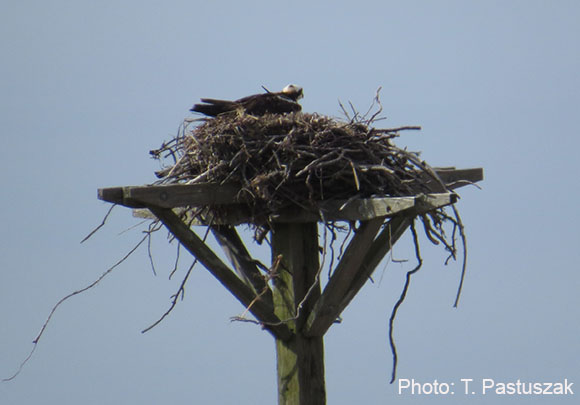 Snowy's back on his nest on Nantucket! We don't know exactly when he got back, but Trish Pastuszak photographed him and his mate at their nest. We'll try to trap him in late May to get the old transmitter off his back and give him a color band so we'll be able to recognize him in the future.
Snowy's back on his nest on Nantucket! We don't know exactly when he got back, but Trish Pastuszak photographed him and his mate at their nest. We'll try to trap him in late May to get the old transmitter off his back and give him a color band so we'll be able to recognize him in the future.
Belle, Nick, and Hackett are all back. Hackett is waiting for his mate Holly, who survived a series of violent storms as she moved through the Carolinas, to return to their nest. [I was sure that Holly was dead and had even posted a version of this update announcing her demise when she showed back up!]. Nick is hanging around where there are 2 nest platforms on Tangier Island. Maybe we can get some eyes on the nests a little later in the spring to see if he nests this year. It wasn't clear last year what happened, but he did not nest. We don't know if he started and the nest failed or if he never got paired up.
Flow (Essex, MA) and Shana (St. John's, Newfoundland) are hunkered down, waiting for I don't know what. Flow's only on his 2nd migration north, and these "teenagers" never do anything on time, so I'm not surprised there. Shana can't be in any rush to get back to Newfoundland, as they're still iced over up at that latitude.
2017 - The Year in Review
2 January 2017
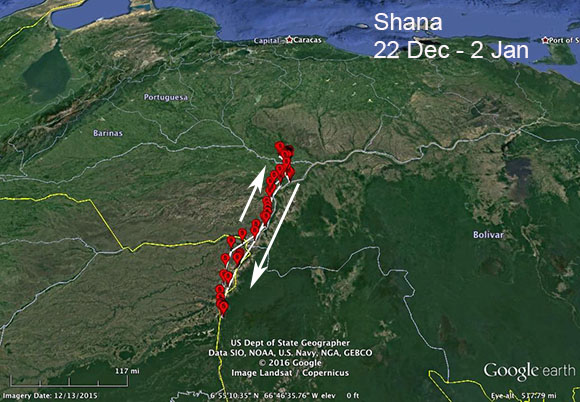 Happy New Year to all! Not much going on with the "flock," other than a strange 400 mi (ca. 600 km), 4-day road trip that one of our Newfoundland adult females (Shana) made up the Orinoco River. She left on Dec 22nd and returned to her winter HQ on the Arauca River in Venezuela's state of Apure in time for Christmas dinner. It's very unusual for an adult to move so far after settling down on its winter range. Up in the D.R. our young Newfoundlander Leif definitely seems to have settled down at Laguna del Rincon. He's made one short foray northeast, but returned quickly to Rincon. It's unlikely that he'll move on to South America, but it wouldn't be completely unprecedented (one other bird has made a big move after the turn of its first year).
Happy New Year to all! Not much going on with the "flock," other than a strange 400 mi (ca. 600 km), 4-day road trip that one of our Newfoundland adult females (Shana) made up the Orinoco River. She left on Dec 22nd and returned to her winter HQ on the Arauca River in Venezuela's state of Apure in time for Christmas dinner. It's very unusual for an adult to move so far after settling down on its winter range. Up in the D.R. our young Newfoundlander Leif definitely seems to have settled down at Laguna del Rincon. He's made one short foray northeast, but returned quickly to Rincon. It's unlikely that he'll move on to South America, but it wouldn't be completely unprecedented (one other bird has made a big move after the turn of its first year).
3 February
Sad news to report. We've lost the last surviving juvenile from our summer expedition to Newfoundland. Leif Erikson had settled down at Laguna del Rincon in southwestern Dominica. After a couple of weeks there, it became obvious that he wasn't going to continue his migration and cross the Caribbean. Instead, he's the 5th out of 5 juvenile Osprey that tried to winter in the D.R. that died. We have no idea what happened to him. His last signals were from the side of a road leading to the lake. The road's not near water and too isolated for there to be enough traffic that we might blame this on a vehicular collision (unlike Edwin alongside I-95 in Connecticut last year). He might have been shot by a hunter, but he wasn't near a fish-farm, so we have no firm evidence. There are some wires along the road, so he might have collided with one of them. We can't blame a Great-horned Owl--a prime suspect when an Osprey roosts in a woodlot and doesn't come out the next morning. So this is just an inexplicable loss. There's a chance still that we might find the transmitter. Right now it's not transmitting because the battery has discharged. If a scavenger flips the body and transmitter over, the battery may recharge and we'll get a signal again. This is what happened to Virginia's transmitter down in the marshes of South Carolina. That transmitter's sitting on my windowsill waiting to be redeployed late this summer. This happened with a few other birds, going all the way back to Bunga in 2004.
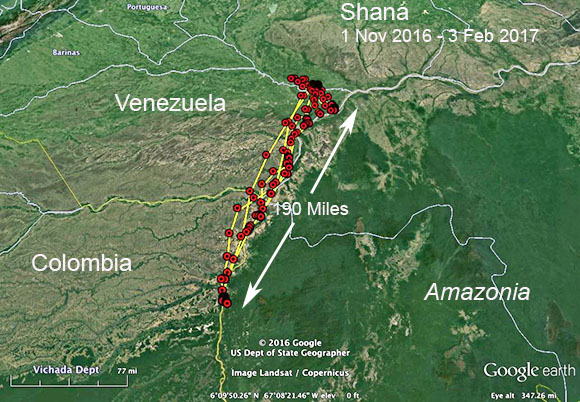 Shana, Newfoundland mother of Virginia and Jocelyn, continues her surprising movement up and down the Orinoco River. Her first trip south was a 2-day trip starting 23 Dec. On 5-8 Jan, she worked her way up and back down the Orinoco River--a 125 mile (ca. 200 km) trip. On 13 Jan, she flew south (upriver) again and is currently in the tiny village of Buena Vista, right at the northern edge of the Amazon Rainforest. She commutes through Colombia briefly between her two favorite spots, which are both in Venezuela. It is very rare for an adult to move this much once they've arrived at their winter locations. Nick (see below) is one of the other outliers in this regard.
Shana, Newfoundland mother of Virginia and Jocelyn, continues her surprising movement up and down the Orinoco River. Her first trip south was a 2-day trip starting 23 Dec. On 5-8 Jan, she worked her way up and back down the Orinoco River--a 125 mile (ca. 200 km) trip. On 13 Jan, she flew south (upriver) again and is currently in the tiny village of Buena Vista, right at the northern edge of the Amazon Rainforest. She commutes through Colombia briefly between her two favorite spots, which are both in Venezuela. It is very rare for an adult to move this much once they've arrived at their winter locations. Nick (see below) is one of the other outliers in this regard.
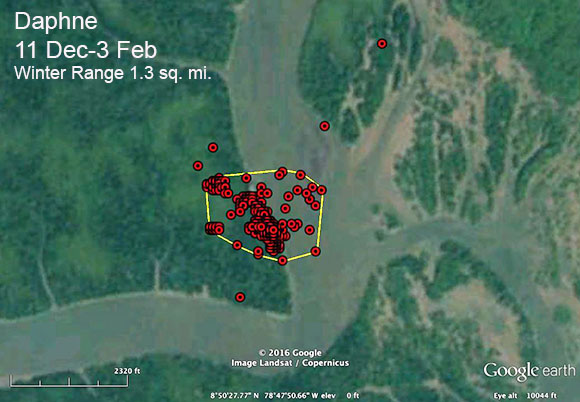 Daphne, our other Newfoundland adult female, although a bit extreme, is more typical, having settled down on the shores of the Gulf of Panama. Since 11 December, 95% of her locations are in an area of only 1.3 square miles! While the size of her winter range is typical (if a bit on the small side), the location is not. She's only the third adult we've tracked to go from Cuba to Central America, rather than South America via Hispaniola. This suggests to me that when she made her first migration south, she took this route, wintered in Panama, and then when it was time to go home, she headed north through Central America, found her way back to Cuba and then back up the east coast to Newfoundland. On her subsequent migrations, she followed more or less this same route.
Daphne, our other Newfoundland adult female, although a bit extreme, is more typical, having settled down on the shores of the Gulf of Panama. Since 11 December, 95% of her locations are in an area of only 1.3 square miles! While the size of her winter range is typical (if a bit on the small side), the location is not. She's only the third adult we've tracked to go from Cuba to Central America, rather than South America via Hispaniola. This suggests to me that when she made her first migration south, she took this route, wintered in Panama, and then when it was time to go home, she headed north through Central America, found her way back to Cuba and then back up the east coast to Newfoundland. On her subsequent migrations, she followed more or less this same route.
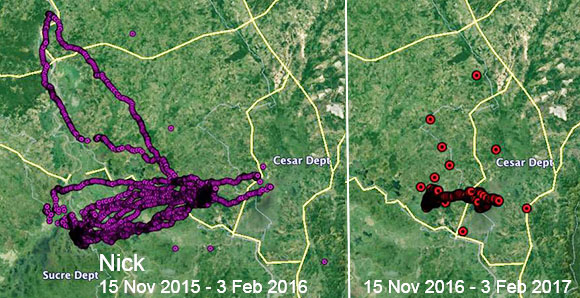 Nick, an adult male from Chesapeake Bay is the other exception to the general rule that most adults barely budge once they're on their winter waters. (One bird spent 5 months in 0.25 square miles!) Last year Nick moved around the Magdalena River Valley in northern Colombia quite a bit. This year he's barely moved. It's very intriguing that the same bird would behave so differently in two years. I suspect some difference in rainfall and levels of innundation are the reason. When Nick leaves South America this spring, we will lose track of him, unless he stops in Haiti. His transmitter uses the now obsolete 2G cell-tower technology, which was phased out in the U.S. as of 31 December. Now, we'll only hear from him when he's down in Colombia. [Editor's note: It turns out we will be hearing from him after all!]
Nick, an adult male from Chesapeake Bay is the other exception to the general rule that most adults barely budge once they're on their winter waters. (One bird spent 5 months in 0.25 square miles!) Last year Nick moved around the Magdalena River Valley in northern Colombia quite a bit. This year he's barely moved. It's very intriguing that the same bird would behave so differently in two years. I suspect some difference in rainfall and levels of innundation are the reason. When Nick leaves South America this spring, we will lose track of him, unless he stops in Haiti. His transmitter uses the now obsolete 2G cell-tower technology, which was phased out in the U.S. as of 31 December. Now, we'll only hear from him when he's down in Colombia. [Editor's note: It turns out we will be hearing from him after all!]
Everything seems to be fine with Belle down on the Rio Madeira. Staddler is still based at Lake Tefe, but he's been commuting across the Solimoes (as the Amazon River is called locally) on a fairly regular basis. Wausau is also doing a bit of local commuting up in Colombia, just east of the Andes. Flow is hunkered down at his Cuban reservoir. This will be his second trip north. Last spring he got the typically late start (27 Apr) that we expect from our "teenage" Ospreys on their first migration north. Look for him to begin migrating a lot earlier this year.
Finally, our 2016 tagged couple, Holly and Hackett, are unknown quantities. We've had sporadic signals from Holly in the far eastern reaches of Brazil over the course of the winter. Hackett is either dead or in some place far from cell towers, or most likely, in Cuba, where there are plenty of cell towers, but not run by any company we can do business with. Best case scenarios for them is that they'll show up in Florida in early March.
9 March
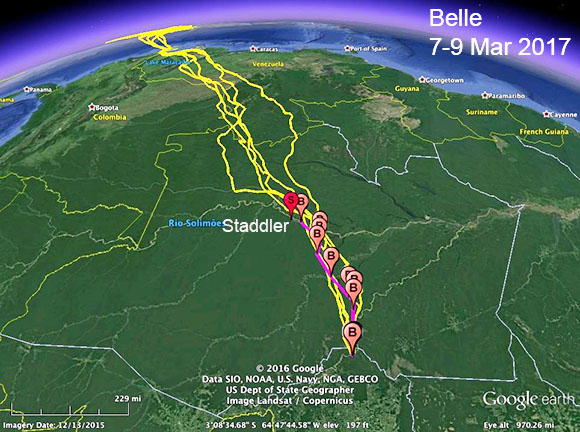 Belle began her record-breaking 6th migration north on March 7th. Around 1PM on the 9th she was just 25 miles east of New Hampshire adult male Staddler. She's flying over well-known terrain. The yellow tracks are her previous spring trips.
Belle began her record-breaking 6th migration north on March 7th. Around 1PM on the 9th she was just 25 miles east of New Hampshire adult male Staddler. She's flying over well-known terrain. The yellow tracks are her previous spring trips.
Everyone else is presumably packing their bags and loading up on fat, the fuel that keeps them going through the spring dash to get home. Spring migration is much more directed than fall. In the fall the birds are in no rush to get to their winter waters. They drift around more (not fighting crosswinds) and take longer stopover breaks than in the spring, when especially the males are in a rush to get home and make sure no young whippersnappers get any ideas about muscling in on their territories.
Nick has been moving around quite a bit, but no signs of a start to his migration. Once he leaves South America, we won't hear from him again until next fall! His transmitter uses the now-obsolete-in-the-US 2G cell tower technology.
Holly has been checking in recently with some frequency after a month hiding out somewhere far from cell towers. We still don't have the full download of her trip south. We're hoping we'll get that when she's close to some towers for an extended period.
16 March
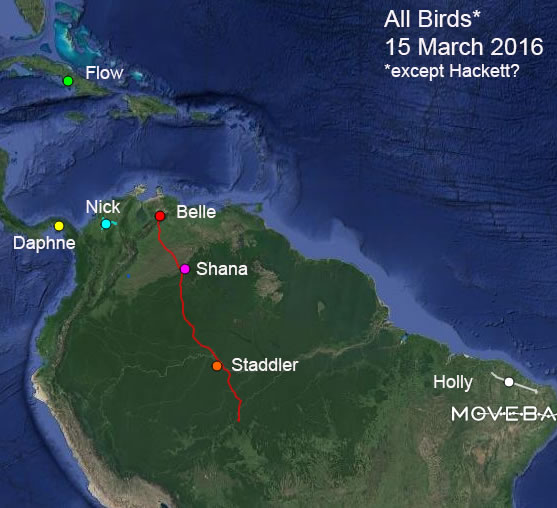 Our second bird is on the move! Holly, an adult female from Annapolis, MD, on the western shore of Chesapeake Bay, set off on her first migration north wearing one of our transmitters. Hers is a GSM, or cell-tower radio. We only hear from her when she's about 15 miles or closer from a cell-tower. During her fall migration we lost track of her going through Cuba--we can't do business with Cuban cell-tower companies, so this is a black hole for our birds--and then had a brief download as she passed over Hispaniola, then nothing until she got to the far eastern tip of Brazil in the state of Rio Grande do Norte. Her winter range included an area where she was in reach of a tower and another where she wasn't. So we got a signal from her about once a month. In the end of February she moved into range of a tower and we began to get fairly regular messages. On the 14th or 15th she began the trip north. We're missing the data from her trip south, so we don't know exactly how she arrived, but the trip north should take her along the northern tier of South American countries to the Paraguana Peninsula on the eastern side of the Gulf of Venezuela.
Our second bird is on the move! Holly, an adult female from Annapolis, MD, on the western shore of Chesapeake Bay, set off on her first migration north wearing one of our transmitters. Hers is a GSM, or cell-tower radio. We only hear from her when she's about 15 miles or closer from a cell-tower. During her fall migration we lost track of her going through Cuba--we can't do business with Cuban cell-tower companies, so this is a black hole for our birds--and then had a brief download as she passed over Hispaniola, then nothing until she got to the far eastern tip of Brazil in the state of Rio Grande do Norte. Her winter range included an area where she was in reach of a tower and another where she wasn't. So we got a signal from her about once a month. In the end of February she moved into range of a tower and we began to get fairly regular messages. On the 14th or 15th she began the trip north. We're missing the data from her trip south, so we don't know exactly how she arrived, but the trip north should take her along the northern tier of South American countries to the Paraguana Peninsula on the eastern side of the Gulf of Venezuela.
Belle left the Rio Madeira on the 7th, 3 days later than her departure last year, but caught up a day by the time she across the Andes in Venezuela.
21 March
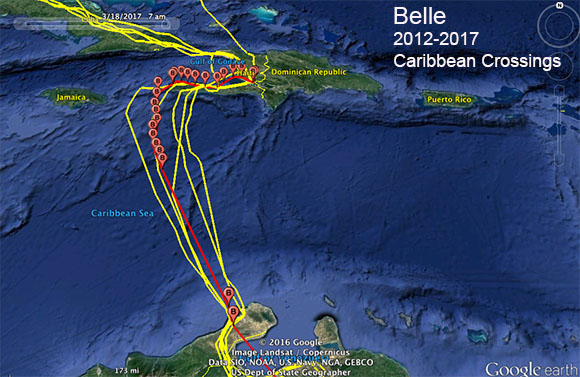 Belle is safely across the Caribbean for the 6th time. She is certainly a creature of habit. The yellow tracks are her crossings from 2012-2016. When she leaves the Guajira Peninsula in northern Venezuela, she tracks northwest, probably pushed by the Trade Winds. When she makes landfall in southwestern Haiti, the shortest route home would be to continue northwest to Cuba, a distance of about 100 miles. This is what most north-bound Ospreys do. But Belle has a favorite fishing hole about 200 miles east of where she arrived in Haiti. It's Lake Azuei, one of two rift-valley lakes that lie below sea level along the Haiti-Dominican Republic border.
Belle is safely across the Caribbean for the 6th time. She is certainly a creature of habit. The yellow tracks are her crossings from 2012-2016. When she leaves the Guajira Peninsula in northern Venezuela, she tracks northwest, probably pushed by the Trade Winds. When she makes landfall in southwestern Haiti, the shortest route home would be to continue northwest to Cuba, a distance of about 100 miles. This is what most north-bound Ospreys do. But Belle has a favorite fishing hole about 200 miles east of where she arrived in Haiti. It's Lake Azuei, one of two rift-valley lakes that lie below sea level along the Haiti-Dominican Republic border.
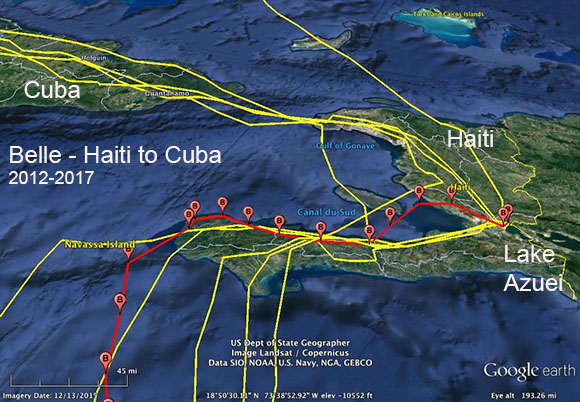 The detour adds over 300 miles (500 km) to her trip, but of course she doesn't know that. She discovered Lake Azuei on her first migration north in 2012. Since then she has stopped in to fish on 3 of her 5 trips south and, with this year's visit, 4 of 6 trips north. On her first visit we got a full day of locations from one spot out on a marsh. This almost never happens with a live bird. I was convinced that she was a goner and had written an obituary for the website. Before I could post it, her signals started moving again, and 5 years later she's back to the same spot!
The detour adds over 300 miles (500 km) to her trip, but of course she doesn't know that. She discovered Lake Azuei on her first migration north in 2012. Since then she has stopped in to fish on 3 of her 5 trips south and, with this year's visit, 4 of 6 trips north. On her first visit we got a full day of locations from one spot out on a marsh. This almost never happens with a live bird. I was convinced that she was a goner and had written an obituary for the website. Before I could post it, her signals started moving again, and 5 years later she's back to the same spot!
Nick, our Chesapeake Bay male (tagged in 2013) began his 4th trip north wearing a cell-tower transmitter on the 20th, 2 days later than last year. I have written earlier that we would lose his signal once he got back to the States because his transmitter uses the 2G network, which is being phased out. But I just learned from Microwave Telemetry that they have negotiated a deal with a new carrier that will enable us to continue to receive data from Nick.
Holly, an adult female from Annapolis, MD, is moving north, but in an area free of cell towers.
29 March
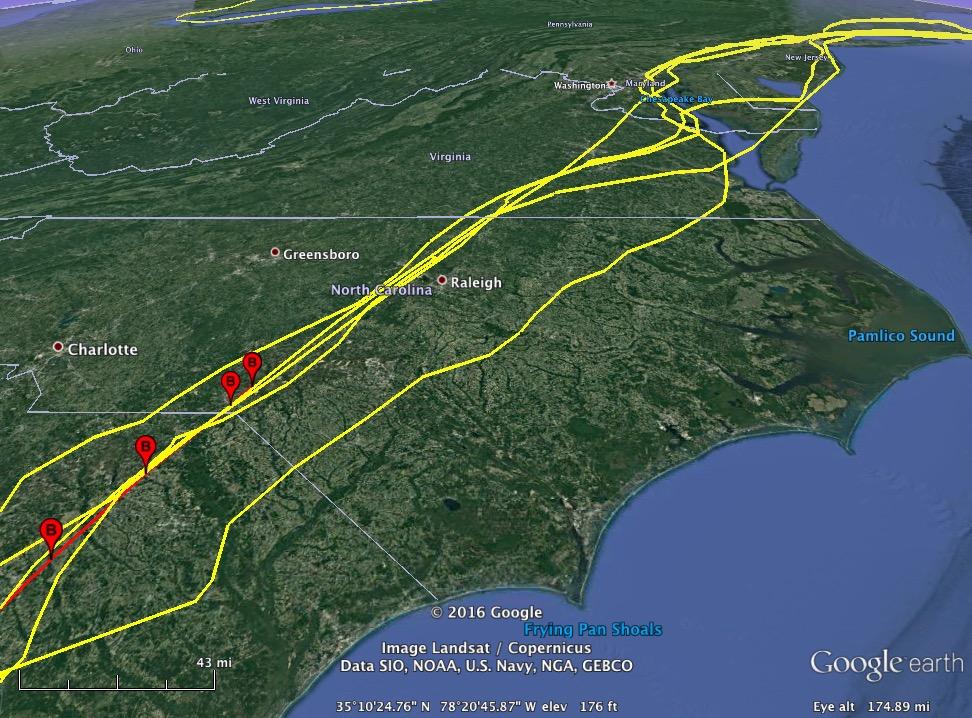 Belle is in North Carolina, following in her wingbeats from 4 of her previous 5 spring migrations. Except for 2014, each spring she (or he--Belle may have some transgender issues because we identified Belle as a female, but Belle's migration behavior suggests Belle should be "Beaux" but Dick Jennings saw Belle after his/her first migration north and saw a strong breast band, which would suggest Belle is Belle and not Beaux) has flown northeast across the state, passing between Chapel Hill and Raleigh [One of my old English teachers is twitching in his grave after that sentence went out over cyberspace]. No other Osprey in North America has been followed for this many migrations, and I suspect that includes Europe as well. Certainly, no Osprey tagged as a juvenile has provided this much information about the species' migration biology. Go Belle!
Belle is in North Carolina, following in her wingbeats from 4 of her previous 5 spring migrations. Except for 2014, each spring she (or he--Belle may have some transgender issues because we identified Belle as a female, but Belle's migration behavior suggests Belle should be "Beaux" but Dick Jennings saw Belle after his/her first migration north and saw a strong breast band, which would suggest Belle is Belle and not Beaux) has flown northeast across the state, passing between Chapel Hill and Raleigh [One of my old English teachers is twitching in his grave after that sentence went out over cyberspace]. No other Osprey in North America has been followed for this many migrations, and I suspect that includes Europe as well. Certainly, no Osprey tagged as a juvenile has provided this much information about the species' migration biology. Go Belle!
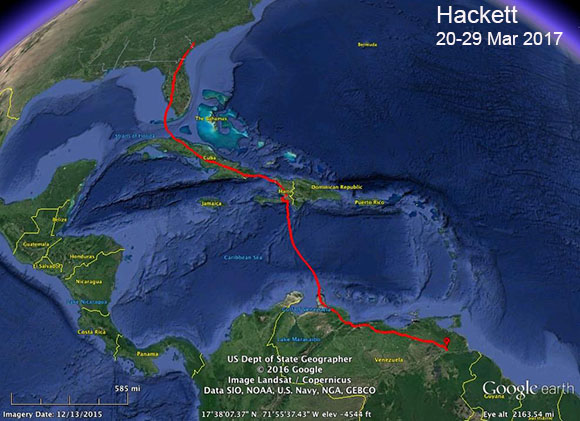 Hackett, our adult male from the western shore of Chesapeake Bay near Annapolis, MD, along just popped back up! He's been rather chatty since he got back online, texting us about where he's been all winter. We were almost certain that he had wintered in Cuba, given his radio silence since last fall. It's rare for a bird to get past Cuba and not check in at all passing through Haiti, the D.R., and northern Colombia and Venezuela. But as the data came in--bit by bit, or byte by byte, we discovered that Hackett is one sneaky Osprey! He dodged all those cell towers (both on the way south and the spring return) and wintered at the western edge of the Orinoco River delta. He started his migration on the 20th and 10 days later was in South Carolina, having covered about 2,500 miles (ca. 4,000 km) in 10 days. That's really fast. He is clearly in a hurry to get home.
Hackett, our adult male from the western shore of Chesapeake Bay near Annapolis, MD, along just popped back up! He's been rather chatty since he got back online, texting us about where he's been all winter. We were almost certain that he had wintered in Cuba, given his radio silence since last fall. It's rare for a bird to get past Cuba and not check in at all passing through Haiti, the D.R., and northern Colombia and Venezuela. But as the data came in--bit by bit, or byte by byte, we discovered that Hackett is one sneaky Osprey! He dodged all those cell towers (both on the way south and the spring return) and wintered at the western edge of the Orinoco River delta. He started his migration on the 20th and 10 days later was in South Carolina, having covered about 2,500 miles (ca. 4,000 km) in 10 days. That's really fast. He is clearly in a hurry to get home.
Holly, Hackett's mate, is presumably moving northwest across the northern tier of South America, where cell towers are scarce. She made it all the way from Hispaniola to eastern Brazil last fall without checking in once. We last heard from her on 15 March 300 miles (460 km) west of her winter waters. From that point she still had about 2,300 miles (3,600 km) to go to reach the northern tip of South America on the Paraguana Peninsula, on the eastern edge of the Gulf of Venezuela. That would take 10-14 days, so we should hear from her soon--if she passes by a cell tower before crossing the Caribbean.
Nick is somewhere between South America and Florida. Many north-bound birds go straight to Cuba, so we often don't hear from cell-tower birds until they get to Florida.
Staddler, adult male from coastal New Hampshire, left his winter HQ at Lago (Lake) Tefe along the Amazon river on the 22nd, 3 days later than in 2016. It seems pretty clear that he has been texting with someone in New Hampshire and has been advised that winter is a bit late in passing the baton on to spring up there, so a few days' delay in departure would be a good idea.
31 March
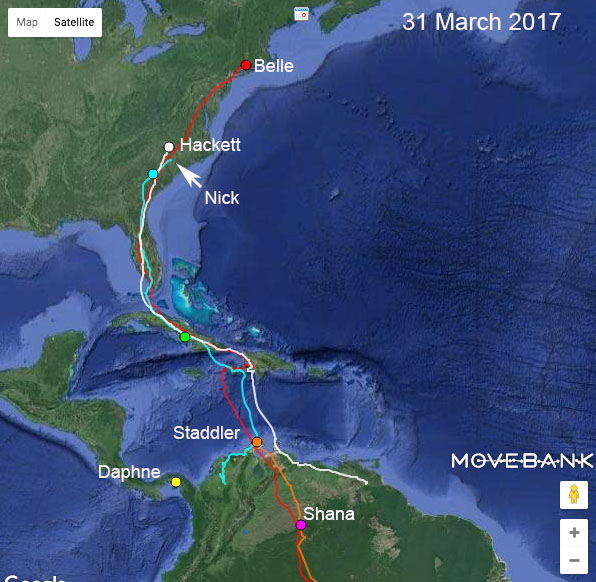 Nick, a cell-tower bird from the Chesapeake Bay is back on the air in South Carolina, just a few days' travel to his home on Tangier Island. Nick's transmitter is old--built in 2013--and uses 2G cell-tower technology, which has been phased out by one carrier. We thought that meant that Nick would "go dark" when he got back to the states, but Microwave Telemetry has negotiated a deal with a different carrier, so we'll be getting data from Nick after all.
Nick, a cell-tower bird from the Chesapeake Bay is back on the air in South Carolina, just a few days' travel to his home on Tangier Island. Nick's transmitter is old--built in 2013--and uses 2G cell-tower technology, which has been phased out by one carrier. We thought that meant that Nick would "go dark" when he got back to the states, but Microwave Telemetry has negotiated a deal with a different carrier, so we'll be getting data from Nick after all.
Belle is probably home on Cape Cod already, just in time for a late winter storm! She left the winter waters 3 days later than last year and got home 2 days later than last year, so she made up a day en route.
Hackett continues to push north toward his nest in Annapolis. No data from his mate Holly for more than 2 weeks, which is worrisome. By now she should have made it to the states, where she'd find a cell tower, but she was starting from so far east in Brazil that it's too early to give up on her.
Our two gals from Newfoundland, Daphne and Shana, seem in no rush to get home. They're due to arrive in late April, so it may be a while before they push north. (Of course now that I've written that, they'll take off later today!)
